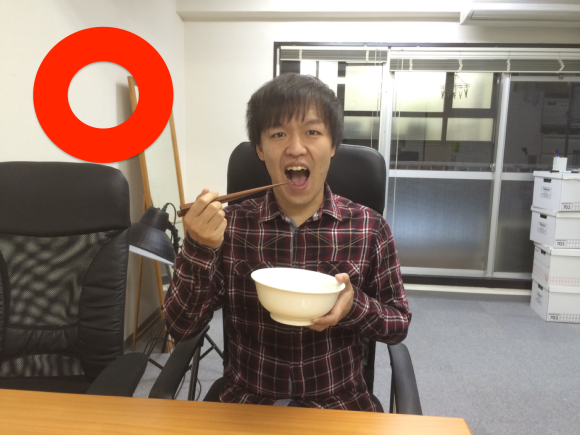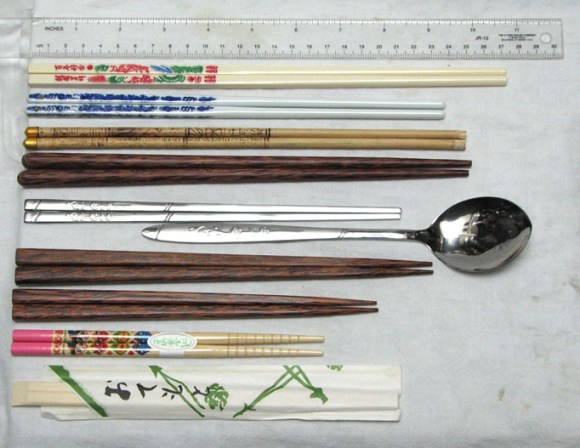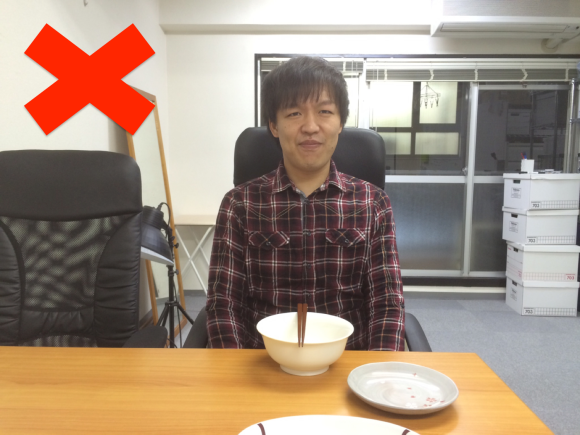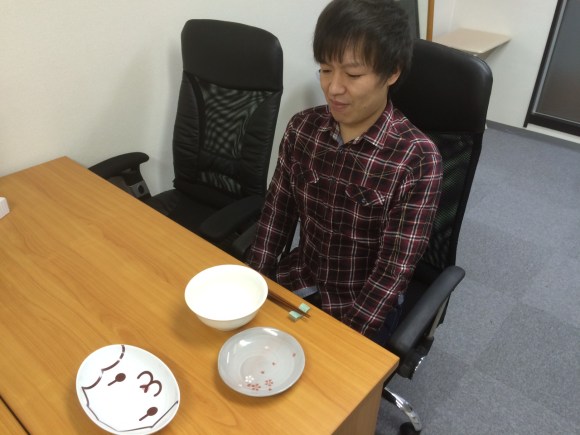
We’ve been seeing a lot of articles recently about how to use Japanese chopsticks correctly. For those of us who grew up using forks and knives, it may seem a bit silly to obsess over holding two sticks at the correct angles. If you plan on visiting, living in, or especially working in Japan at some point, though, it may be a good idea to get out a protractor and practice those angles to save yourself a lot of embarrassing moments with friends and coworkers later.
To help you out, we here at RocketNews24 have compiled seven facts about chopsticks to help you along in your quest for perfect Japanese table manners. Even if you’re a seasoned chopstick expert, you may learn a thing or two from our advanced-level tips.
#1: In Japan, everybody has their own personal chopsticks
It may sound strange to anyone who grew up in a household where you just used whatever silverware (or plasticware!) was placed in front of you, but in Japan it’s quite common for each member of the family to have his or her own personal pair of chopsticks. Dad has his big, manly ones; mom has her long, thin ones; the kids have Pokémon ones, and they’re all typically washed and reused every day. Use someone else’s chopsticks at your own risk.
▼ Pick the wrong ones and you’ll be using the spoon for a week.
#2: Most Japanese chopsticks are made of wood
As opposed to countries like Korea where metal chopsticks are extremely common, most Japanese chopsticks are made of wood. Wooden chopsticks are preferred since they don’t conduct heat (useful when you’re eating very hot food), provide a more stable grip, and are cheaper to produce. There are chopsticks made out of a variety of other materials, such as luxury chopsticks made of gold or silver, but the second-most common material is plastic, typically used for children’s chopsticks.
▼ Or for Pocky-shaped chopsticks to eat Pocky with.

#3: If the food is hard to pick up with chopsticks, bringing the bowl/plate up to your mouth is acceptable
The first time anyone is given a bowl of miso soup and a pair of chopsticks with no spoon in sight, panic usually takes over, but stay calm! You’re not expected to defy any laws of physics by picking up the soup with chopsticks; simply bring the bowl up to your mouth and drink. That may get you kicked out of some fancy restaurants outside of Japan, but here it’s expected. Feel free to do the same with bowls of rice, or anything else that doesn’t seem like it’d survive the whole trip up from the table to your mouth.
#4: Resting your chopsticks across your plate/bowl is a heinous crime
Resting your chopsticks across your plate/bowl is a big no-no in Japan. To Japanese people, it looks like a bridge over a river, specifically the Sanzu River, the Japanese river of the dead.
▼ You could say the Western equivalent is the River Styx… or River Chopstyx!
When you want to take a break from eating (or you’re being forced to take a break from eating), be sure to place your chopsticks on a rest with the pointed ends going up. If you don’t have a chopstick rest, there’s plenty of ridiculous ones to choose from, or you can make your own origami ones too.
▼ It’s also considered good form to place the chopsticks as close to you as possible, so no one else has to see your dirty utensils.
#5: There is an extra-fancy “two hand chopstick raise” that can be used to impress
Most people just grab their chopsticks with one hand and get right down to business eating, but if you really want to show off your skills, then give this little beauty a try:
You basically use your right hand to put the tips of your chopsticks into your left hand, rotate your right hand, then slowly raise both hands off the table. Doing so shows extra appreciation for the meal, and will have everyone nodding their heads approvingly at you while tears of joy stream down their cheeks.
#6: Wari-bashi (disposable chopsticks) are everywhere
When you’re out eating, the personal chopsticks go out the window and you just have to use whatever is available. Wari-bashi are extremely common in Japan, and you use them in restaurants, at picnics, at convenience stores, when you visit other people’s houses… basically anywhere imaginable. They’re notoriously difficult to break apart if you’re not used to it, so don’t feel ashamed if you have to buy a couple pairs to practice with in the privacy of your own home.
▼ Then when it comes time to break your own pair apart in public, channel your inner Osaka and give it your best shot.
https://www.youtube.com/watch?v=0PbPdjWlB9k
#7: Using your own chopsticks on a communal plate/bowl will elicit gasps of horror
When people share a meal, quite often there will be one big plate or bowl that they all pick things out of. Whatever you do, don’t use your own wari-bashi to grab anything! Instead, use the pair of serving chopsticks provided to put the food on your plate, then use your own chopsticks to bring it up to your mouth. Our well-mannered reporter below will demonstrate using some delicious imaginary food.
And that’s all there is to it! You may now consider yourself an expert in Japanese table manners. Just follow the above, be sure to slurp your noodles and soup really loud, and you’ll probably start getting invitations to fancy Japanese dinners before you know it.
Images: RocketNews24




 Japan’s public broadcaster renames “correct way” to hold chopsticks, gets nods of approval
Japan’s public broadcaster renames “correct way” to hold chopsticks, gets nods of approval Bowl or chopsticks: Which one should you pick up first?
Bowl or chopsticks: Which one should you pick up first? Is there any point to holding your chopsticks the “correct” way? Let’s find out【Experiment】
Is there any point to holding your chopsticks the “correct” way? Let’s find out【Experiment】 Which is Considered Worse, Holding Your Chopsticks the Wrong Way, or Eating Noisily?
Which is Considered Worse, Holding Your Chopsticks the Wrong Way, or Eating Noisily? Challenge Yourself, Make Friends or Make Enemies with these Space-Age Chopsticks
Challenge Yourself, Make Friends or Make Enemies with these Space-Age Chopsticks Top Japanese cosplayer Enako returns to Comiket after 6 years, creates mayhem with admirers
Top Japanese cosplayer Enako returns to Comiket after 6 years, creates mayhem with admirers Private booths are coming to Japan’s Shinkansen bullet trains even sooner than we’d thought【Video】
Private booths are coming to Japan’s Shinkansen bullet trains even sooner than we’d thought【Video】 Rakuten randomly offers 58 New Year’s osechi feasts in Japan, but did we get a star or a dud?
Rakuten randomly offers 58 New Year’s osechi feasts in Japan, but did we get a star or a dud? 7-Eleven Japan has a hack for creating insanely delicious potato chip rice meals
7-Eleven Japan has a hack for creating insanely delicious potato chip rice meals Eternal Shojo Cafe opens in Tokyo, serves up ‘90s anime nostalgia by the plateful
Eternal Shojo Cafe opens in Tokyo, serves up ‘90s anime nostalgia by the plateful Dragon Quest Burgers and Slime drinks are coming to McDonald’s Japan【Video】
Dragon Quest Burgers and Slime drinks are coming to McDonald’s Japan【Video】 Tokyo fish market breaks New Year auction record as single fish sells for over 500 million yen【Vid】
Tokyo fish market breaks New Year auction record as single fish sells for over 500 million yen【Vid】 More JSDF recruitment posters get a moe makeover in Ibaraki
More JSDF recruitment posters get a moe makeover in Ibaraki What makes a good boss in Japan? Workers sound off in survey
What makes a good boss in Japan? Workers sound off in survey More Than a Capsule Stay: Why Solo Travelers Choose “global cabin Yokohama Chinatown”
More Than a Capsule Stay: Why Solo Travelers Choose “global cabin Yokohama Chinatown” Starbucks Japan ready to get Year of the Horse started with adorable drinkware and plushies【Pics】
Starbucks Japan ready to get Year of the Horse started with adorable drinkware and plushies【Pics】 Japanese beef bowl chain Sukiya’s 2026 Smile Box lucky bag basically pays for itself
Japanese beef bowl chain Sukiya’s 2026 Smile Box lucky bag basically pays for itself Hayao Miyazaki says Happy New Year to Studio Ghibli fans with new art for Year of the Horse
Hayao Miyazaki says Happy New Year to Studio Ghibli fans with new art for Year of the Horse Cup Noodle tries an authentic Jiro-style ramen, but something’s not quite right
Cup Noodle tries an authentic Jiro-style ramen, but something’s not quite right The best Starbucks Japan Frappuccinos we want to drink again in 2026
The best Starbucks Japan Frappuccinos we want to drink again in 2026 We revisited Sweets Paradise after a decade to see if Japan’s dessert buffet still delivers
We revisited Sweets Paradise after a decade to see if Japan’s dessert buffet still delivers That time Seiji called JASRAC to ask why he didn’t get paid royalties for his song being on TV
That time Seiji called JASRAC to ask why he didn’t get paid royalties for his song being on TV We found possibly the quietest Japanese-style hotel in Tokyo’s bustling Shinjuku district
We found possibly the quietest Japanese-style hotel in Tokyo’s bustling Shinjuku district Pizza Hut Japan’s hot lucky bags are perfect for a New Year’s pizza party
Pizza Hut Japan’s hot lucky bags are perfect for a New Year’s pizza party Japan’s oldest largetooth sawfish in captivity back on display in Mie Prefecture
Japan’s oldest largetooth sawfish in captivity back on display in Mie Prefecture 7-Eleven Japan starts new temporary luggage storage service in over 300 branches
7-Eleven Japan starts new temporary luggage storage service in over 300 branches Disillusionment at Tsukiji’s tourist-target prices led us to a great ramen restaurant in Tokyo
Disillusionment at Tsukiji’s tourist-target prices led us to a great ramen restaurant in Tokyo Starbucks teams up with 166-year-old Kyoto doll maker for Year of the Horse decorations【Photos】
Starbucks teams up with 166-year-old Kyoto doll maker for Year of the Horse decorations【Photos】 Tokyo considering law requiring more trash cans following litter increase in heavily touristed area
Tokyo considering law requiring more trash cans following litter increase in heavily touristed area Tokyo’s Tsukiji sushi neighborhood asks tour groups to stay away for the rest of the month
Tokyo’s Tsukiji sushi neighborhood asks tour groups to stay away for the rest of the month Tokyo event lets you travel back in time, for free, to celebrate 100 years since Showa era start
Tokyo event lets you travel back in time, for free, to celebrate 100 years since Showa era start Japan may add Japanese language proficiency, lifestyle classes to permanent foreign resident requirements
Japan may add Japanese language proficiency, lifestyle classes to permanent foreign resident requirements Sanrio theme park in Japan announces plans to expand into a Sanrio resort
Sanrio theme park in Japan announces plans to expand into a Sanrio resort Stamina-destroying “Paralysis Noodles” are Tokyo’s newest over-the-top ramen innovation
Stamina-destroying “Paralysis Noodles” are Tokyo’s newest over-the-top ramen innovation Survey asks foreign tourists what bothered them in Japan, more than half gave same answer
Survey asks foreign tourists what bothered them in Japan, more than half gave same answer Japan’s human washing machines will go on sale to general public, demos to be held in Tokyo
Japan’s human washing machines will go on sale to general public, demos to be held in Tokyo Japan’s deadliest food claims more victims, but why do people keep eating it for New Year’s?
Japan’s deadliest food claims more victims, but why do people keep eating it for New Year’s? We deeply regret going into this tunnel on our walk in the mountains of Japan
We deeply regret going into this tunnel on our walk in the mountains of Japan Studio Ghibli releases Kodama forest spirits from Princess Mononoke to light up your home
Studio Ghibli releases Kodama forest spirits from Princess Mononoke to light up your home Major Japanese hotel chain says reservations via overseas booking sites may not be valid
Major Japanese hotel chain says reservations via overseas booking sites may not be valid Put sesame oil in your coffee? Japanese maker says it’s the best way to start your day【Taste test】
Put sesame oil in your coffee? Japanese maker says it’s the best way to start your day【Taste test】 No more using real katana for tourism activities, Japan’s National Police Agency says
No more using real katana for tourism activities, Japan’s National Police Agency says Starbucks Japan reveals new sakura drinkware collection, inspired by evening cherry blossoms
Starbucks Japan reveals new sakura drinkware collection, inspired by evening cherry blossoms Updated cherry blossom forecast shows extra-long sakura season for Japan this year
Updated cherry blossom forecast shows extra-long sakura season for Japan this year You can rest your chopsticks on a lot of different things in Japan
You can rest your chopsticks on a lot of different things in Japan Chopstick anxiety: Painfully shy Japanese diners struggle with communal restaurant containers
Chopstick anxiety: Painfully shy Japanese diners struggle with communal restaurant containers Japan’s new edible chopsticks have a special flavor, but don’t taste like “food”
Japan’s new edible chopsticks have a special flavor, but don’t taste like “food” China’s Baidu announces high-tech chopsticks that will keep you safe, skinny and healthy
China’s Baidu announces high-tech chopsticks that will keep you safe, skinny and healthy Brilliantly designed chopsticks are going to change the way you set the table
Brilliantly designed chopsticks are going to change the way you set the table LED gaming chopsticks are here for your mid-game munchies or whenever you eat in the dark
LED gaming chopsticks are here for your mid-game munchies or whenever you eat in the dark We test out the new gaming chopsticks that bring gaming PC looks to your dinner table【Photos】
We test out the new gaming chopsticks that bring gaming PC looks to your dinner table【Photos】 Japanese convenience store will now ask customers who ask for a fork to use chopsticks instead
Japanese convenience store will now ask customers who ask for a fork to use chopsticks instead Electric chopsticks that make low-salt food taste salty developed by Meiji University
Electric chopsticks that make low-salt food taste salty developed by Meiji University Dining with Totoro — 400-year-old ceramics company makes Studio Ghibli chopstick rests【Photos】
Dining with Totoro — 400-year-old ceramics company makes Studio Ghibli chopstick rests【Photos】 This is a pen: These “disposable chopsticks” are all you need to write a letter!
This is a pen: These “disposable chopsticks” are all you need to write a letter! Huge new Ghibli chopstick series means you’ll always have company with your meals【Pics】
Huge new Ghibli chopstick series means you’ll always have company with your meals【Pics】 Chopsticks: why every gamer should know how to use them
Chopsticks: why every gamer should know how to use them Gamer-friendly, non-instant yakisoba you can eat with your fingers【Sora Kitchen】
Gamer-friendly, non-instant yakisoba you can eat with your fingers【Sora Kitchen】 Miss Manners: A pro gives us pointers on Japanese dining decorum
Miss Manners: A pro gives us pointers on Japanese dining decorum
Leave a Reply